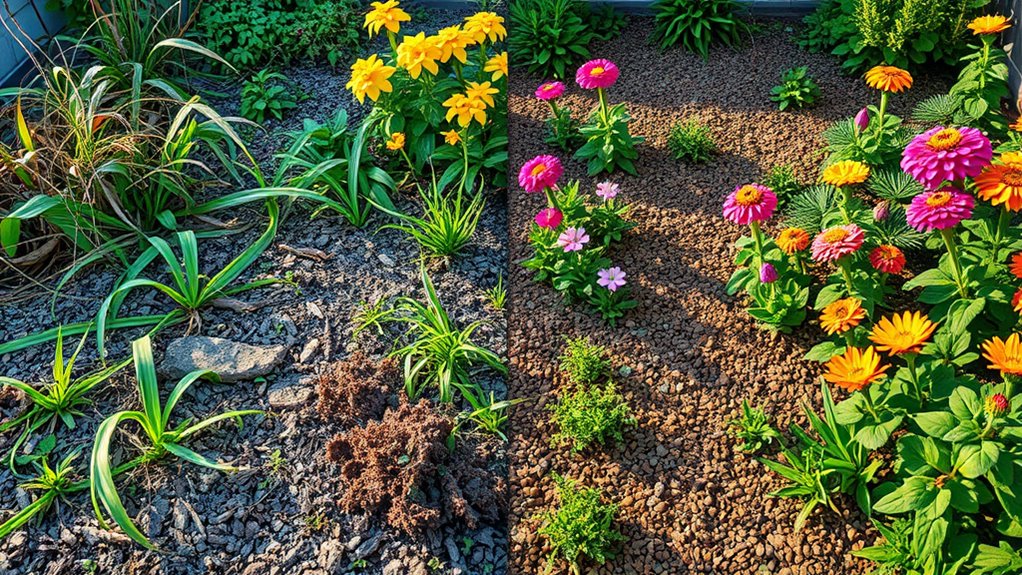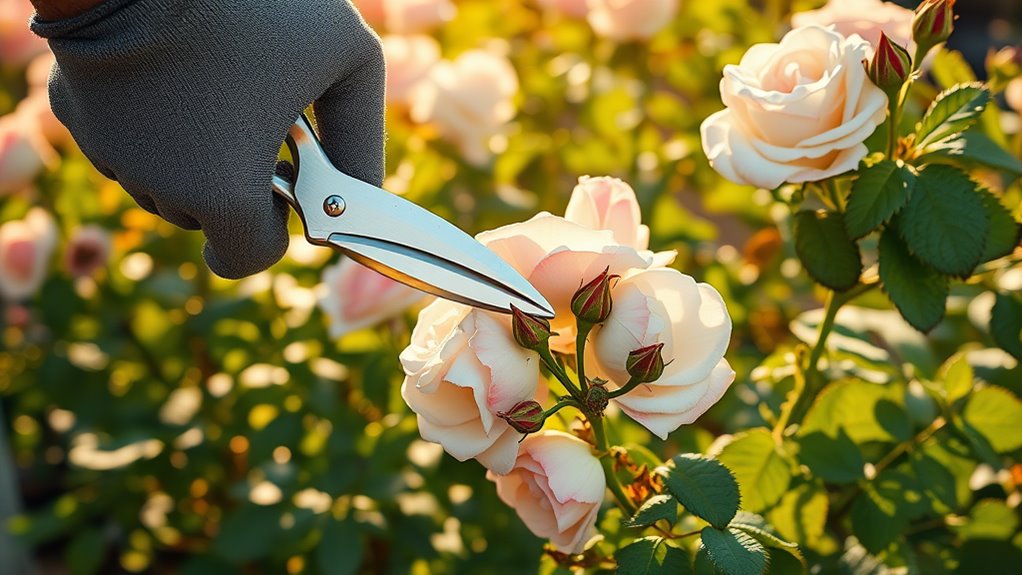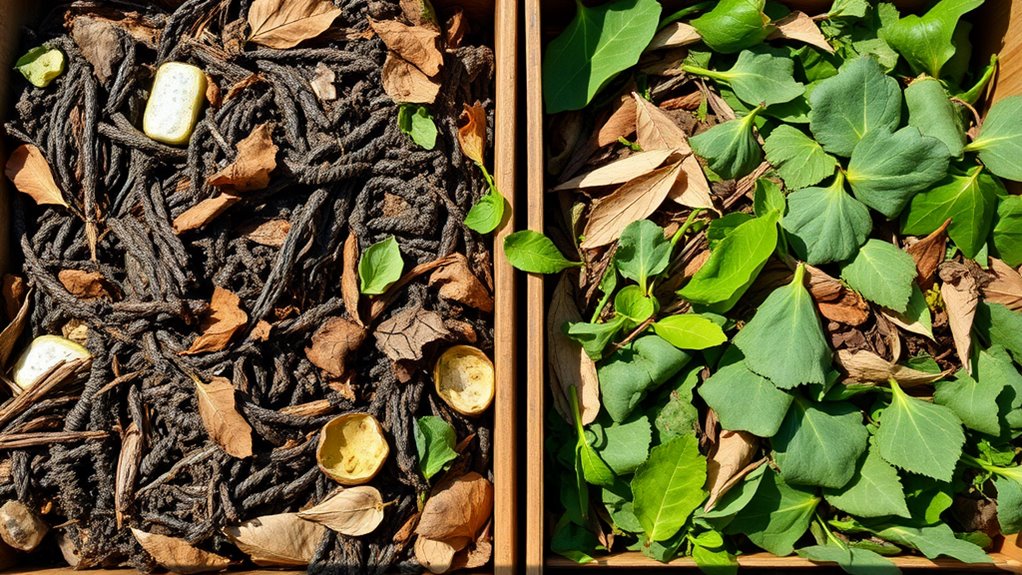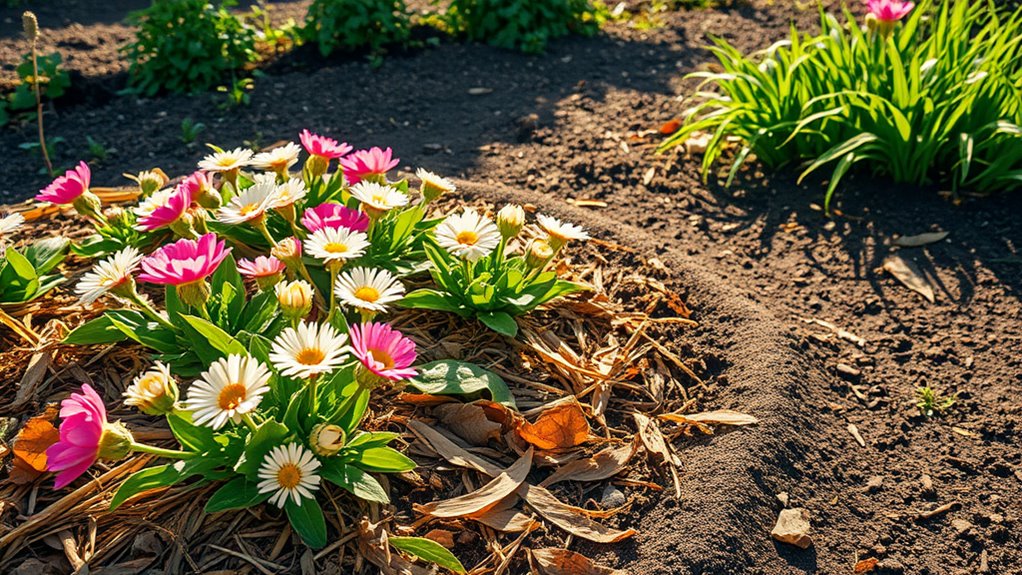From Weeds to Wonders – How Mulch Changed My Garden
You’ve probably battled relentless weeds that smother your plants, stealing nutrients and sunlight while draining your energy with constant pulling. But mulch transformed my garden, suppressing weed growth by up to 90%, retaining soil moisture, and enriching the soil naturally through options like wood chips or landscape fabric. It’s practical—clear the area, apply 2-4 inches evenly, and watch your space thrive with less effort. Check out the full tips to spark your own garden revival.
Key Takeaways
- Mulch suppresses weeds by up to 90%, transforming overgrown gardens into tidy, thriving spaces.
- It retains soil moisture, promoting healthier plants and reducing watering needs during dry periods.
- Using organic mulches like wood chips enriches soil as they decompose, boosting garden vitality.
- Proper application involves clearing weeds and spreading 2-4 inches evenly around plants for best results.
- Regular maintenance with mulch conserves water, prevents erosion, and fosters a sustainable, weed-free ecosystem.
The Weed Overrun Garden
Before you tackled the weeds in your garden, they likely dominated every inch, smothering your plants and turning simple upkeep into a daily battle that drained your time and energy.
Weeds stole nutrients, blocked sunlight, and spread rapidly, leaving you frustrated and exhausted from constant pulling.
To regain control, explore mulching secrets that prevent such invasions; these include layering organic materials to suppress seeds and retain soil moisture, reducing weed emergence by up to 90%. Additionally, mulching helps maintain consistently moist conditions, promoting a thriving garden even during dry spells.
You’ll save hours weekly by creating a protective barrier that fosters healthier plants without chemicals, making maintenance practical and efficient.
By incorporating mulch, you can also boost soil health to create a flourishing oasis that enhances overall garden vitality.
My First Encounter With Mulch
My first encounter with mulch revealed its game-changing potential in my weed-battled garden. You’ve likely struggled with relentless weeds too, so imagine applying a thick layer and watching it block sunlight, smothering those pests while retaining soil moisture. Moreover, fall mulching plays a key role in preparing gardens for winter by enhancing soil health and shielding plants from cold weather. It’s simple: prepare your bed, spread mulch, and observe the transformation.
| Aspect | Before Mulch |
|---|---|
| Weed Growth | Overwhelming |
| Soil Moisture | Quickly Evaporating |
| Garden Appeal | Chaotic and Untidy |
| Effort Required | Constant Weeding |
This practical step cut my maintenance time, letting you enjoy a tidier space effortlessly. Exploring mulch types further enhanced my garden’s plant health and growth.
Exploring Different Mulch Options
As you explore mulch options for your garden, you’ll quickly discover that choices range from organic materials like wood chips and straw, which enrich soil as they decompose, to inorganic ones like landscape fabric or gravel, which provide long-lasting weed suppression. Moreover, incorporating backyard solutions can help you source free materials like fallen leaves to enhance your mulching strategy naturally.
Organic mulches, such as bark or leaves, boost nutrients and foster beneficial microbes, making them ideal for vegetable beds.
Inorganic options like rubber mulch resist decay and suit high-traffic areas, minimizing upkeep.
Consider your climate and plant needs: in rainy regions, choose fast-draining types to prevent rot, ensuring a thriving, low-effort garden transformation.
Additionally, to enhance soil health further, try incorporating kitchen scraps from your organic composting efforts into your mulch for added nutrients.
Step-by-Step Mulch Application
Applying mulch properly enhances your garden’s health and suppresses weeds effectively. You’ll transform your space by following these practical steps.
-
Clear the area: Remove debris and weeds from your garden beds to create a clean surface, ensuring mulch contacts the soil directly for better results.
-
Measure and prepare: Calculate the needed mulch depth—typically 2-4 inches—and water the soil lightly to help it settle before application.
-
Spread evenly: Use a rake or shovel to distribute mulch uniformly around plants, leaving a small gap at stems to prevent rot and promote air flow.
-
Edge and tamp: Define bed edges with a tool for neatness, then gently press mulch down to secure it against wind and erosion.
Enhancing Soil Fertility With Mulch
Beyond its role as a weed barrier, mulch enriches your soil’s fertility by decomposing into organic matter that adds essential nutrients.
As you choose organic options like composted leaves or bark, these materials break down, releasing nitrogen, phosphorus, and potassium to feed your plants.
You’ll notice improved microbial activity, which enhances soil structure and aeration, making it easier for roots to thrive.
For best results, apply a 2-4 inch layer annually, mixing in some directly into the topsoil to boost nutrient availability without overwhelming your garden’s ecosystem. Incorporating homemade alternatives can further enhance this process by promoting eco-friendly gardening.
Track changes over seasons to optimize your approach.
Additionally, addressing common composting issues can help maintain the effectiveness of your mulch by preventing problems that might hinder soil enrichment.
Keeping Soil Moist Through Mulching
Mulch conserves soil moisture by forming a protective barrier that minimizes evaporation and shields the ground from harsh weather. As you apply it around your plants, you’ll reduce watering needs and foster resilient roots in drier conditions.
-
Select the right mulch: Choose materials like straw or bark chips; spread them 2-4 inches deep to create an effective moisture-retaining layer over your soil.
-
Monitor soil temperature: You’ll keep the ground cooler in summer heat, preventing rapid moisture loss and maintaining even hydration for your garden beds.
-
Control weed competition: By suppressing weeds, mulch helps you focus moisture on desired plants, ensuring they thrive without sharing resources.
-
Adjust for seasons: In windy periods, add extra mulch layers so you maintain steady soil dampness, supporting vigorous growth year-round.
To further enhance moisture retention during extreme heat, consider integrating effective watering strategies. One such strategy is deep watering, which enables you to water once a week for optimal root penetration and sustained plant health.
Natural Pest Management Using Mulch
You can turn mulch into a natural pest repellent by choosing types like cedar or eucalyptus, which emit scents that deter insects from your garden beds.
It also creates physical barriers that block pests from reaching plant roots and stems, reducing the need for chemical interventions.
With this approach, you’ll enhance organic insect control, fostering a healthier ecosystem while minimizing damage from common garden foes.
Additionally, these mulch-based strategies align with natural DIY techniques that promote a pest-free garden without any financial costs.
This method complements other unconventional remedies for effective natural pest control.
Mulch Pest Repellent
One effective way mulch acts as a natural pest repellent is by forming a protective barrier that discourages insects and weeds, helping you maintain a healthier garden with minimal effort. This method enhances your garden’s resilience naturally.
-
Physical obstruction: Mulch creates a dense layer that blocks pests like aphids from reaching plant stems, forcing them to seek easier targets.
-
Microclimate alteration: It moderates soil temperature and humidity, making environments less appealing for pests such as slugs that prefer moist, cool spots.
-
Nutrient release: Decomposing organic mulch emits compounds that repel insects like ants, reducing infestations without chemicals.
-
Beneficial organism support: Mulch fosters predators like ground beetles, which actively hunt and control pest numbers in your garden.
Barriers From Mulch
Barriers created by mulch offer a straightforward defense in natural pest management, forming impenetrable layers that shield your plants from unwanted intruders. By using mulch as a barrier, you’re actively preventing pests from accessing your plants, which is both cost-effective and environmentally friendly. Apply a 3-4 inch layer around the base of your plants to maximize this effect. This not only blocks pests but also suppresses weeds that could harbor them. For imagery, here’s a table showing different mulches and their barrier roles:
| Mulch Variety | How It Acts as a Barrier |
|---|---|
| Wood Bark | Provides a rough, impenetrable surface |
| Hay Straw | Creates a dense cover that pests avoid |
| Composted Leaves | Forms a natural shield against soil-borne pests |
You’ll find that integrating mulch barriers into your routine gardening practices leads to a healthier, more resilient garden.
Organic Insect Control
While mulch effectively blocks pests as a barrier, it also enhances organic insect control by fostering a natural environment that repels and manages unwanted bugs. You can create a balanced ecosystem in your garden that supports beneficial insects, reducing chemical needs.
-
Attract beneficial predators: Mulch harbors ladybugs and ground beetles, which devour aphids and caterpillars, keeping your plants pest-free.
-
Retain soil moisture: It maintains ideal humidity levels that favor predatory insects over pests like spider mites.
-
Suppress pest habitats: By smothering weeds, mulch eliminates hiding spots for bugs such as slugs.
-
Promote microbial activity: Organic mulch boosts soil microbes that naturally deter harmful insects, enhancing plant resilience.
Before and After: Garden Transformation
When you first applied mulch to your garden, it transformed the space from a weedy, barren patch into a thriving oasis.
Before, invasive weeds dominated, choking plants and depleting soil nutrients, while the exposed ground eroded and dried out quickly.
After mulching, weeds were effectively suppressed as the layer blocked sunlight and seeds, allowing your desired plants to grow stronger and healthier.
Moisture retention improved, reducing water loss and fostering deeper roots.
This practical shift not only enhanced visual appeal with lush greenery but also boosted soil fertility through gradual organic breakdown, making your garden more resilient and productive.
Daily Care for Mulched Areas
Once you’ve mulched your garden, you’ll need to regularly check the soil’s moisture levels to ensure it’s not too dry or overly saturated, which helps your plants thrive.
Don’t forget to pull any emerging weeds promptly from the mulched areas, as they can compete for nutrients and disrupt your garden’s appearance.
Moisture Checks
How do you maintain optimal moisture in your mulched garden? It’s all about daily vigilance to prevent drying or waterlogging, ensuring your plants thrive without waste. Regular checks help you balance hydration effectively.
-
Probe the soil depth: Insert a moisture meter 4-6 inches under the mulch to accurately read levels, avoiding surface deception.
-
Manual touch test: Gently dig into the soil with your fingers; it should feel damp like a wrung-out sponge, not wet or dusty.
-
Schedule timed inspections: Check moisture every morning, noting patterns to adjust watering based on weather and mulch thickness.
-
Monitor plant responses: Watch for subtle signs like drooping leaves, indicating you need to add water before stress sets in.
Weed Removal
While mulch acts as a barrier against weeds, you’ll still need to tackle any intruders daily to keep your garden thriving.
Begin by inspecting mulched areas each morning for sprouts, focusing on spots where weeds might poke through. Pull them gently by hand to avoid disturbing the mulch, which helps retain soil moisture and nutrients.
For stubborn roots, use a small weeding tool to extract them fully without shifting the layer. Dispose of weeds in a sealed bag or compost far from the garden to prevent reseeding.
This routine ensures a healthier, weed-free space, enhancing your plants’ growth.
Sustainable Benefits of Mulch Over Time
As you explore the long-term use of mulch in your garden, it actively enhances sustainability by conserving water and enriching soil health.
This practice reduces your environmental footprint while boosting garden vitality over time.
-
Conserve water efficiently: Mulch minimizes evaporation, keeping soil moist and cutting irrigation needs by up to 50%, saving you money and resources.
-
Enrich soil naturally: As it decomposes, mulch adds organic matter, improving fertility, structure, and microbial activity for healthier plant growth.
-
Prevent erosion effectively: It stabilizes soil against wind and rain, maintaining topsoil integrity and reducing landscape degradation.
-
Boost biodiversity practically: Mulch creates habitats for beneficial insects and worms, fostering a balanced ecosystem that naturally controls pests.





